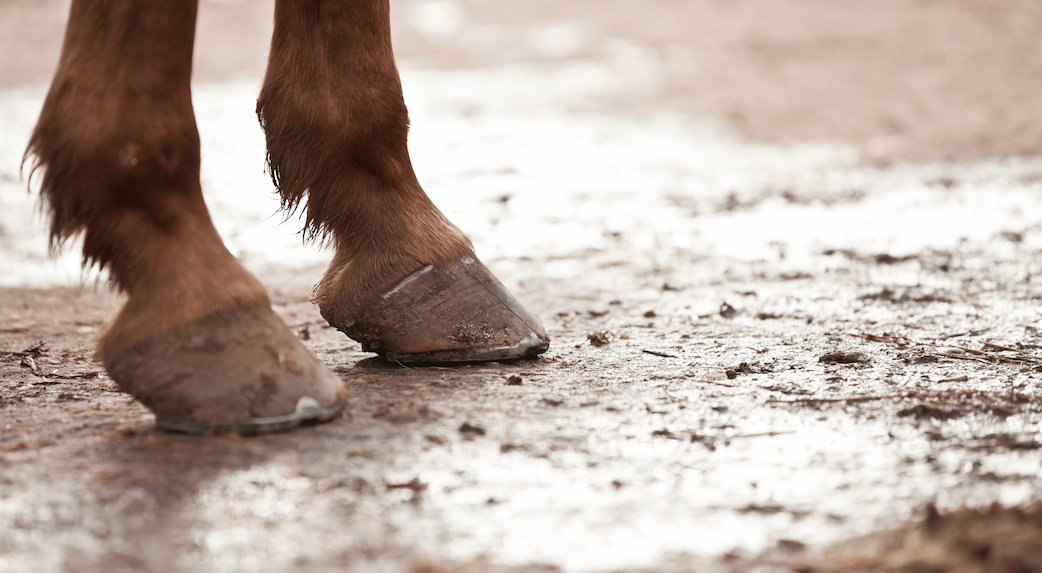Causes of Laminitis
Laminitis is a painful inflammation of the sensitive structures within the hoof. It can cause lameness and can lead to permanent damage to the foot if not treated promptly. In severe cases the pedal bone can rotate or collapse, this is extremely debilitating, painful and may require euthanasia.
Unfortunately there is no cure for laminitis, however symptoms can be managed to improve quality of life. The condition can be time consuming and costly to manage, with affected animals often requiring vast amounts of supportive care.
There are many factors that can cause laminitis. As horse owners, it is important to be aware of these so that measures can be taken to minimise the risk of such a devastating condition. Here we have outlined some of the main causes of laminitis.
Excess weight
Overweight or obese horses and ponies are at a much higher risk of developing laminitis, due to the extra strain that carrying excess weight puts on the limbs and sensitive structures within the hoof. Additionally, obesity can also lead to hormonal imbalances that may contribute to the development of laminitis.
It is important that horse’s have their weight and body condition monitored on a regular basis. If you horse is overweight or obese, their weight should be managed using a combination of dietary changes and controlled exercise, to promote gradual weight loss.
High starch diet
Starch is a carbohydrate that is found in many plants, including grains that are present in many concentrate feeds. When starch is digested, it is broken down into simple sugars such as glucose, which can be rapidly absorbed into the bloodstream.
Horses fed a diet that is high in sugar and starch are more susceptible to developing laminitis. The horse’s digestive tract is not designed to cope with large quantities of starch. Excessive starch consumption can lead to a build up of lactic acid in the hind gut, altering their pH. This can kill some of the good bacteria population within the caecum, resulting in a release of endotoxins that enter the bloodstream. This process can trigger an episode of laminitis.
Excessive grazing on lush grass which is high in sugar, can also lead to laminitis. For horses and ponies prone to laminitis we recommend restricting grazing. The best time for grazing is between the hours of dusk to dawn as this is when the grass’ sugar content is at its lowest.
Horses who are fed high volumes of starch and sugar on a regular basis are much more likely to be overweight or obese.
It is very important that horses and ponies with or prone to laminitis are fed a diet that is low in sugar and starch. If you have any concerns about your horse’s diet, contact a vet or nutritionist who will be able to advise further.
Concussion
In general, any type of trauma that causes injury to the blood vessels and laminar tissue within the hoof can lead to the development of laminitis.
The most common types of trauma to the hoof include:
- Concussive trauma from repetitive exercise on hard and uneven surfaces
- Penetrative trauma
- Mechanical trauma as a result of tendon and ligament injuries altering the weight bearing forces on the hoof
- Thermal trauma such as burns and frostbite
Toxins
Certain infections can result in secondary laminitis, as a result of toxins being released into the bloodstream and causing an inflammatory response. One of the most common instances of this is retained placenta. After a mare has foaled it is important that she passes all of her placenta. A vet should be called to examine this, as retained placenta can release toxins that may cause laminitis.
Disease
Certain diseases can also put horses at a greater risk of developing laminitis. Horses with Equine Metabolic Syndrome, a condition that affects the horse’s ability to regulate blood glucose levels are put at a greater risk of developing laminitis.
Horses with Cushing’s disease, a hormonal condition affecting the pituitary gland are also much more susceptible to developing laminitis.
Summary
Laminitis cannot be cured, but with the correct management horses and ponies can live comfortably with the condition and still maintain an athletic career. As owners, it is important to be aware of the factors that can cause laminitis, so we can minimise risk in the day to day management of our horses.

